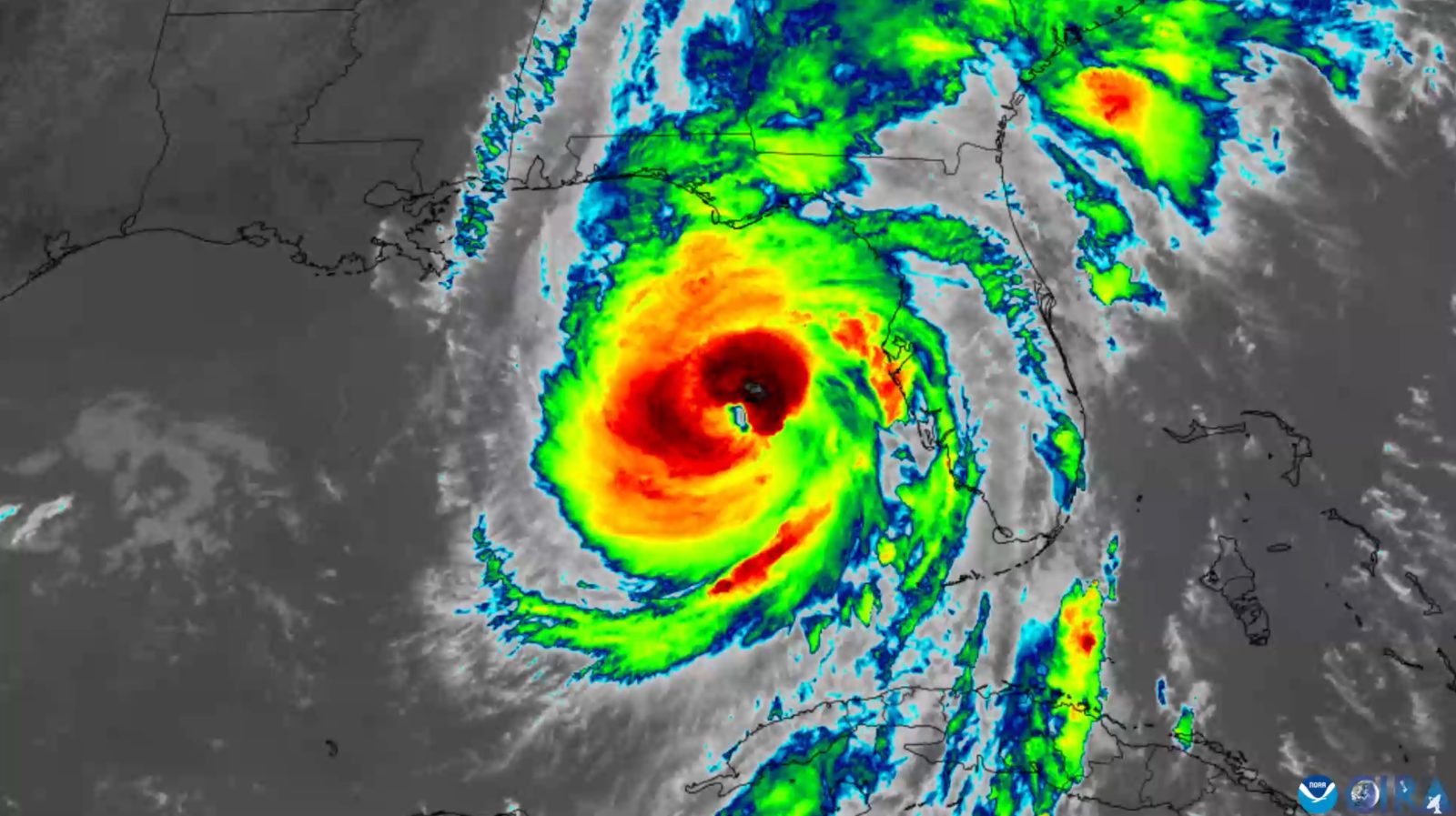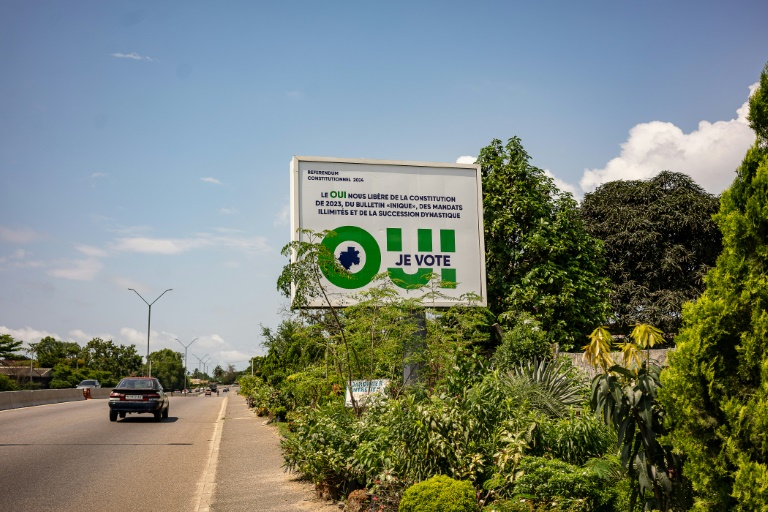Hurricane Helene has made its way through the southeast US as the strongest storm of the 2024 season and potentially the costliest storm ever recorded. But if you watch US media, you’d barely know that the true culprit behind Helene’s record-breaking strength is us – the climate change that we humans caused by burning fossil fuels.
Hurricane Helene spent the last week traveling through the Gulf of Mexico, eventually making landfall in Florida and leaving a swath of devastation as far north as Tennessee and North Carolina.
The storm was exceptional for its strength, but also for the high speed at which it traveled, reaching much farther inland than most storms.
In particular, one does not expect Asheville, North Carolina, over 400 miles from where Helene made landfall and nestled high in the Blue Ridge Mountains, to be vulnerable to hurricanes – and yet the “biblical devastation” seen there is readily apparent in photographs of the area, or in this story of a 7,000lb Rivian which was swept away (and yet, it still works).
And East Tennessee experienced a “1-in-5000 years rain event” according to a TVA spokesperson. (Thankfully, some people in the area have an electric car in the house to help keep the lights on by powering the house from their car.)


Images from CSU/CIRA & NOAA.
As of now, with 180 deaths (and counting) attributed to it, Helene is the second-deadliest hurricane to hit the US in 50 years (after Katrina), and early estimates of the amount of damage done range from ~$30 billion to ~$160 billion – the upper end of which would make it the most expensive hurricane to hit the US, ahead of Katrina and Harvey.
Much of these record costs will likely be paid by taxpayers, as FEMA funds are used for storm recovery in these areas. Congress may come back for a special session to address a shortfall in FEMA funds – and more outlays like this can be expected as climate change continues to make storms stronger. (Though if the republican Project 2025 had any say about it, hurricane-affected areas might get no help at all)
How climate change and storms are connected
As one might expect out of massive, species-wide global efforts to spew enormous amounts of heat-trapping pollution into the atmosphere, human-caused climate change tends to have a lot of varied effects on the environment.
Some of these effects are better understood than others, with scientists working every day to figure out exactly the magnitude of the effects that rising temperatures have on myriad aspects of the environment. Scientists tend to be precise in their language, so even if certain climate effects are plausible and supported by early data, scientists may still speak in a couched manner which can lead to a perception of uncertainty.
But one thing that is well-understood is that a warmer atmosphere, and warmer water, means stronger storms.
The reason behind this is fairly simple. Heat is energy, so more heat means more energy. When a hurricane crosses over warm ocean water, that warmth helps to feed the storm and make it stronger.
Currently, the world is about 1.3 degrees Celsius warmer on average than it was before humans started affecting the climate by burning fossil fuels. While that doesn’t sound like a lot, averaged over the entire ocean we have added the energy equivalent of several billion nuclear bombs in just the last couple decades. That’s a lot of extra energy to feed storms, meaning a lot more destruction when they roll through town.
That extra energy hasn’t been evenly distributed, either. Some of the places that have seen the most warming are the Gulf of Mexico and the Eastern Seaboard of the US, the most densely populated part of the world’s largest historical emitter. Around this time last year, Gulf waters might have set a world record for the hottest seawater ever recorded at 101ºF/38ºC.
Warmer water also means higher sea levels, which means more flooding due to storm surge. Much has been said about how sea level rise is caused by melting ice sheets, but a less often mentioned feature is the thermal expansion of water. As water (or any substance) gets warmer, it expands. Averaged over the entire ocean, this makes the ocean bigger and therefore contributes to rising sea levels.
Warmer air also contributes. Warmer air is able to hold more moisture than colder air, which means more precipitation.
So, combining the effects of warmer and wetter air, we have more significant storm surge and more rainfall, meaning more dangerous hurricanes. After all, in a hurricane, it’s not the wind that’s the most dangerous, it’s the water.
More warmth, more damage
All of this warmth also means a longer hurricane season, with storm season starting earlier and ending later.
The reason hurricane season comes in the warmer months is because that’s when ocean and air temperatures are higher, contributing to all the above effects. But if the atmosphere and ocean are warmer, then the period of time in the year where conditions are right for hurricanes will be wider, which means hurricane season is longer and harder to contend with.
This will also tend to mean that storms develop more rapidly. Storms typically gain energy while traveling over the ocean (due to warm water, as mentioned above), and having more energy available means they can develop faster. Faster-developing storms mean less notice to make preparations, less time to evacuate populations from danger zones, and more stress on infrastructure in making those rapid preparations and evacuations.
And most of all, stronger storms means more damage. The US has had increasingly-more “billion-dollar disasters” in recent years. Since 1980, the US averaged 8.5 natural disaster events with more than a billion dollars worth of damage per year (adjusted for inflation). But in the last 5 years, that average has ballooned to 20.4 events, with 2023 setting the record at 28 billion-dollar disasters.
It’s gotten bad enough that Florida is going through an insurance crisis, with rates skyrocketing and many homes becoming uninsurable. It’s happening in other states too.
These numbers are often ignored when it comes to the “cost” of carbon reduction. Environmental opponents say it’s too expensive to clean up humanity’s act, but in fact it’s much more expensive if we don’t take action (by sixfold, according to research).
So we now know how storms are influenced by climate change, how Helene has been historic, how its records were contributed to by climate change, and how devastating an impact these climate-affected storms have in aggregate.
High ocean temps fueling Helene were made 200-500x more likely by climate change
So this storm is more damaging than expected, and is damaging areas that were thought to be safe from storms. But was it truly “caused” by climate change? How do we account for this?
It turns out, something called climate attribution science can answer our questions.
Climate attribution science is a relatively new branch of climate science which seeks to answer the question of how much more likely extreme weather events are made by climate change.
It does this by looking at the natural variability of temperatures, then seeing how much that variability has shifted as a result of the additional heat that human fossil fuel emissions have trapped in the atmosphere and oceans.
Climate Central has packaged the information from these measurements into an online tool which can show just how much hotter ocean surface temperatures are in any given location, and how much more likely those hot ocean temperatures were made by climate change.
And, since the Gulf of Mexico has warmed faster than much of the rest of the world’s oceans, we can see that the 1.7ºC/3.1ºF warming in the area where Helene started its rapid intensification from a category 1 to category 4 storm was made 400x more likely by climate change. Other high ocean temps in the area were made 200-500x more likely by climate change, all of which helped to fuel the storm.

Notably, there is an asterisk on this data, which as you can see at the top of the screenshot is not the most current possible data. The reason for this is because the National Center of Environmental Information is headquartered in Asheville, North Carolina, a place that was previously considered relatively safe from storms. But as we learned earlier in this article, Asheville is no longer quite so safe, and the NCEI is currently underwater due to flooding from Helene.
Attribution science does not make the argument, however, that we would not have hurricanes without climate change. Clearly we would still have them, but climate change creates the conditions that make hurricanes stronger and more historic.
Dr. Friederike Otto, one of the founders of the field of attribution science, puts it this way:
“It’s not like without climate change we wouldn’t have hurricanes. But it’s the same kind of causation that we use when we talk about smoking. You would still have lung cancer in the world if people wouldn’t smoke, but if you do smoke, you have a much much higher likelihood [of getting lung cancer]. And so there is a causal relationship between that and lung cancer.”
Dr. Friederike Otto
The increased chance of storms like these happening, and higher intensity of storms when they do happen, are important to keep in mind when planning infrastructure. If infrastructure is built to withstand a 1,000-year storm, and that storm becomes not only more common but stronger and hits a wider area, then your infrastructure will be overwhelmed. Even if a storm is only 10 or 20 percent stronger, if that suddenly goes past the threshold that your infrastructure can handle, it turns a storm that would have been relatively “fine” into a big problem.
Despite these interactions being fairly well understood, and it being clear that hurricanes are getting stronger due to climate change, climate change still didn’t manage to make it into almost any TV news coverage about the storm.
According to Media Matters’ analysis, out of 1,355 minutes and 468 segments about Hurricane Helene, only 15 segments, or 3%, mentioned climate change at all. Cable news networks mentioned it 11 times, and broadcast TV networks mentioned it 4 times.
Among the cable news stations, MSNBC fared best, mentioning climate change 6 times out of 73 segments. CNN trailed with 5 mentions in 235 segments. And, as you might expect, Fox News, which is owned by climate denier Rupert Murdoch who has been a major driving force in spreading propaganda to support environmental destruction worldwide, aired 87 segments and did not mention climate change once.
Broadcast news did similarly poorly, with ABC mentioning climate 2 times in 31 segments, NBC mentioning it twice in 19, and CBS zero times in 23.
Media matters selected a few standout segments from ABC, CNN and MSNBC.
In an ABC segment, weather anchor Sam Champion explained how warmer gulf waters lead to rapid intensification of storms, and rising sea levels make storm surge more dangerous:
In an MSNBC segment, meteorologist Angie Lassman put it succinctly, citing Climate Central’s analysis showing that high surface temps, which fuel stronger storms, are made hundreds of times more likely due to human-caused climate change caused by the burning of fossil fuels:
And on a long CNN segment, meteorologist Chris Gloninger cited Climate Central’s analysis, mentioned the higher moisture content of warmer air, and said how deep ocean warming has resulted in a “new normal” where hurricanes are no longer slowed down by the churning of colder deep ocean waters to the surface:
And, as usual, climate scientist Michael Mann was involved with a standout segment when he dropped by CNN to explain what’s happening from a scientist’s perspective, and to make the important connection to the upcoming US election, where there is a stark difference between the candidates, with one wanting to solve this problem and the other denying it exists (or even trying to make it worse):
The overall lack of coverage highlights a significant issue with tackling climate change. Despite that it is the most important challenge that humanity has ever confronted – after all, nothing matters without clean air, clean water, and a livable environment – relatively few voters put the environment highest on their list of important issues.
That list is instead dominated by any number of other issues that are focused upon in media and which are less important than climate change. Or some of which are indeed related to climate change, such that approaching the climate problem could alleviate other pressures that people perceive as important.
But it’s hard for people to make these connections when media refuses to make them. If all of the media you watch tells you that something is a problem, you are likely to perceive that as a problem, whether it really is one or not. And if they never mention the problem, how are you supposed to learn about it?
This is where we get to the speculative portion of this article, wherein I try to analyze how we got where we are, and how we can solve it.
Make no mistake, the largest and richest industry in the world, the oil industry, is actively lying to you to shift your perceptions about real solutions to the problems they cause. That rich industry also happens to buy a lot of advertising, which makes it harder for ad-funded networks – especially those that are actively in favor of spreading fossil propaganda like the climate denier-run Fox – to speak up against the guys who pay the bills.
Even for algorithmically-based advertising, the same influence is there. Climate change is an issue that requires less, not more, consumption to combat. People who sell things generally like consumption. So any algorithmic news is incentivized to show you fewer climate stories, lest they get fewer sweet sweet consumer clickthroughs.
But there is a much more mundane, and less conspiratorial, explanation for why media doesn’t talk about climate change: because you, dear reader, don’t want to hear about it.
Climate change is an enormous and difficult problem that will require participation from basically everyone on Earth, and all of us will need to learn about what solutions work and how to implement them. These solutions need to be both personal and structural – everyone’s personal carbon emissions need to go down, primarily those of us in rich countries, and also new rules need to be enforced to ensure that companies and people are incentivized to pollute less and/or punished for polluting more.
Frankly, that’s hard, and thinking about it makes people feel bad. So they don’t want to hear about it, because it’s complicated and oftentimes feels impossible.
While people might want to act personally, they’ll think that it’s too expensive or difficult to do so, and they’ll see that not enough action is happening from major players and wonder whether it’s worth the time for them to do much work personally when it seems like nobody else is doing so.
Though we must understand that this attitude is also influenced by propaganda – polluters want you to feel like nothing can be done, because then they can continue the status quo. But we have to avoid this feeling.
I understand these feelings, and it is indeed hard. Trust me, my job is to talk about climate and climate solutions, which means I have to think and talk about this all the time. I see more data and reports than most about the problems with our climate and how we are not doing enough to solve these problems, even though some partial solutions can be remarkably simple.
Climate scientists also feel the call of the void when looking at how society has responded to their repeated attempts to wake the public up about this problem. For a sense of what it’s like, watch the movie Don’t Look Up, which parodizes how society responds to an imminent disaster by simply ignoring it. It’s eerily similar to real life, to the point where I often hated watching the movie because it felt too real. Which is, of course, the entire point of the movie.
So, I go and write about some climate story like this one, and spend a lot of time getting it right, and often enough, any story about climate goes over like a lead balloon (feel free to share this one far and wide to prove me wrong… pretty please, mister algorithm?). When instead, I could have spent 30 minutes writing about some dumb thing Elon did and gotten a much bigger response. As always, petty drama rules the day.
We climate reporters have bills to pay too, and writing about climate doesn’t pay them, because people don’t read them. No wonder people or newsrooms don’t cover it as much as they should when there’s less incentive to do so (as parodied in another scene in Don’t Look Up). I’m probably doing volunteer work today. You’re welcome, I guess.
How do we solve this?
But all of this doesn’t let anyone off the hook. We still need to write about it, to talk about it more, to recognize this problem, to do more to solve it, at all levels. Frankly, it’s like any problem of collective action – everyone has a reason not to act as long as they think nobody else is. Someone has to break the cycle.
Journalists need to do the right thing and connect the dots properly, especially when it’s as easy as adding one or two sentences to the hundreds of segments done about a major news event like Beryl. Say it with me: “human-caused climate change makes waters warmer, which causes stronger storms, which contributed to Beryl’s record-breaking nature.” You can have that sentence royalty-free. Have at it, networks. (You can also get more information from Covering Climate Now, a great resource for climate journalists, which tipped me to the Media Matters study to begin with, and also offered a free quote).
News consumers need to do the right thing and stay informed about this topic. I know it’s hard and annoying, but this problem gets solved better the more informed you are, and the more you talk about it with people you know and who trust you, and the more you act on lowering your personal emissions and demanding that your representatives do more on climate. Anyone reading this already took the first step by going through another one of my huge rants, and for that I thank you (but please, mister algorithm, may I have but a crumbof virality?)
Governments need to do the right thing and act more on climate change even if people don’t rank it as their most important issue. Given that climate change underlies so many other societal problems, acting to solve it can help to solve those other problems too. It’s a problem that changes are often too long-term to be captured in a single term of office, so doing these things won’t always help your re-election campaign but simply be done for the good of society – but that’s the job of a public servant anyway, so get on it.
And fossil fuel companies need to do the right thing and stop exis…. uh, stop the propaganda? I don’t know, let’s just stick with stop existing. But other companies can reduce their exposure to fossil fuels, which consumers say they want anyway (and that means you consumers need to follow up on that promise, by the way).
I understand that that’s a lot of direction I’ve just given to a lot of people, but at the very least, can we start off with acknowledging the reality of science and mentioning it when relevant, like in the case of Hurricane Beryl? Because none of the rest of this happens if we don’t at least recognize the problem and its effects in the first place.
To reduce your carbon footprint and live more sustainably, consider going solar. EnergySage is a free service that connects you with trusted, reputable installers in your area – without having to give up your phone number until you select an installer. Your personalized solar quotes are easy to compare online and you’ll get access to unbiased Energy Advisors to help you every step of the way through EnergySage. Get started today! – ad*








